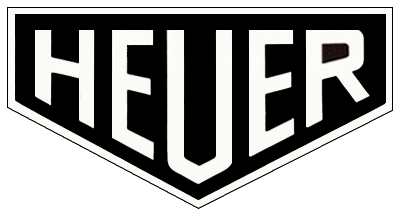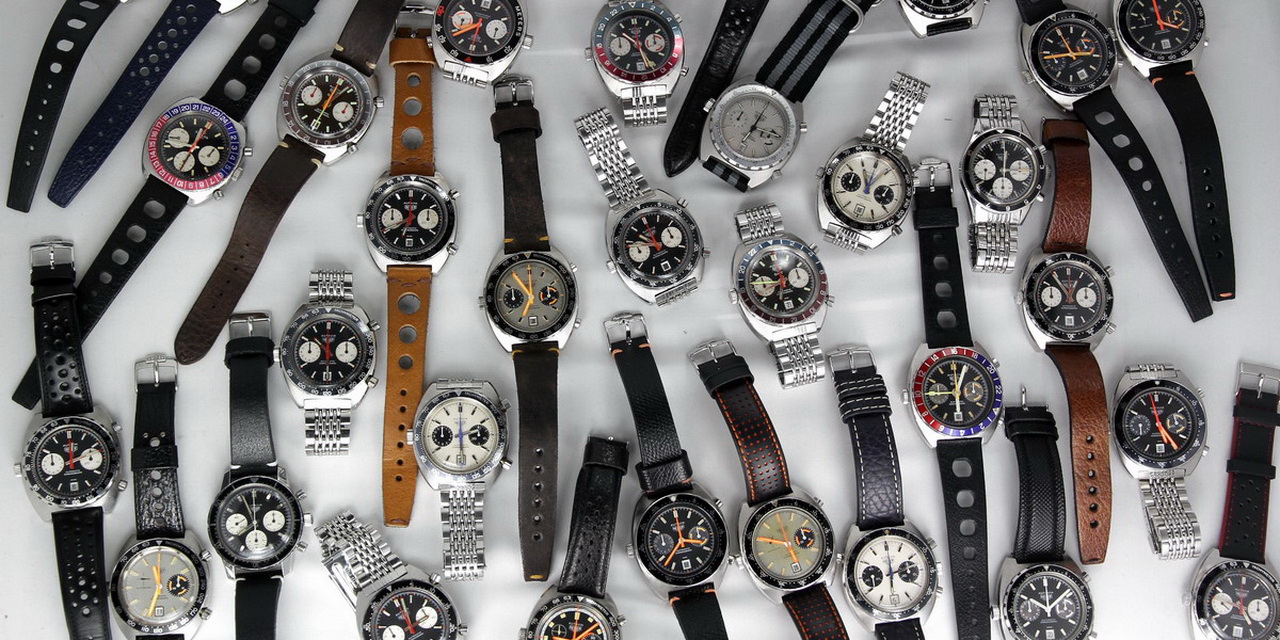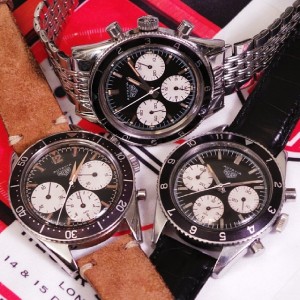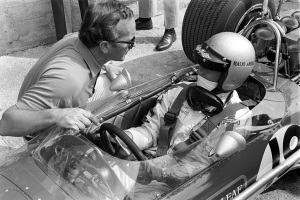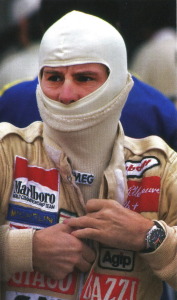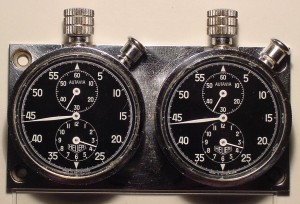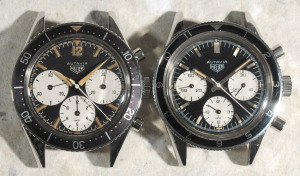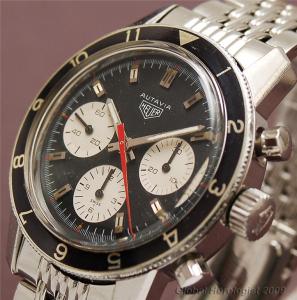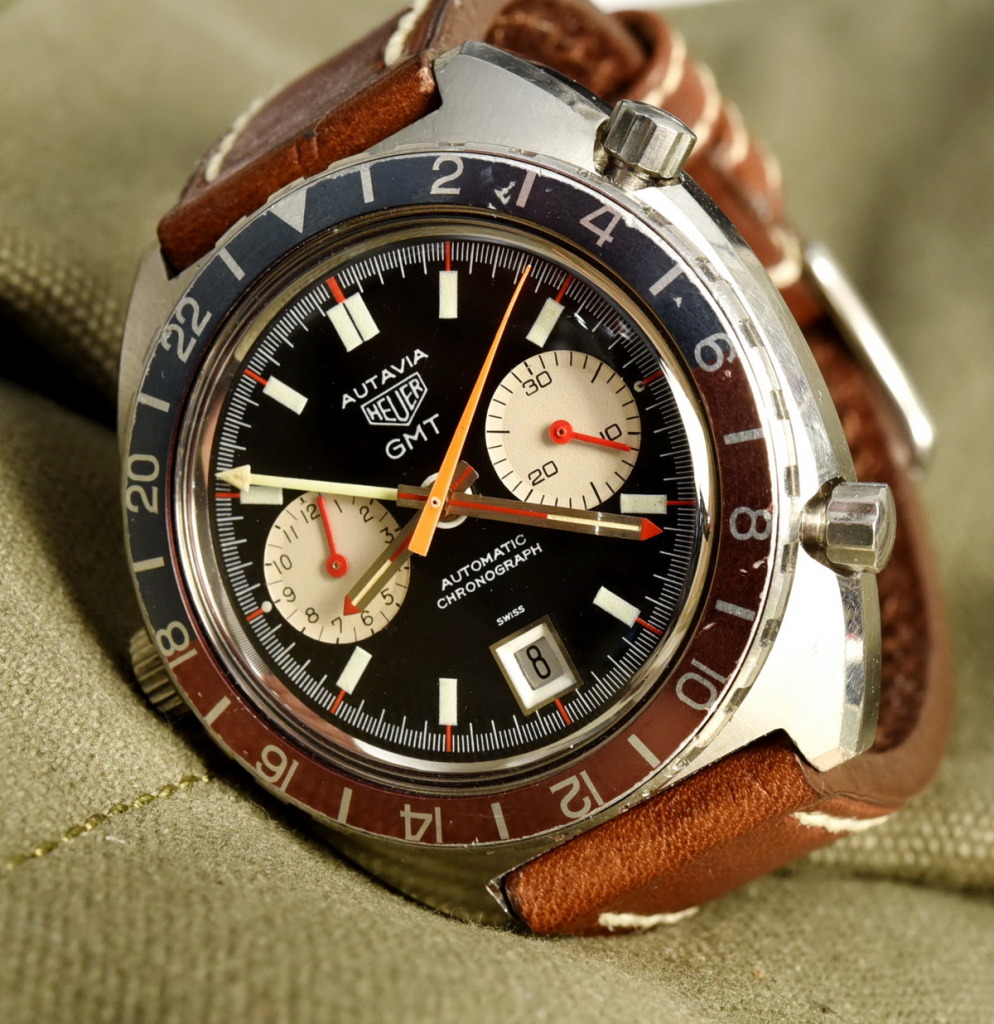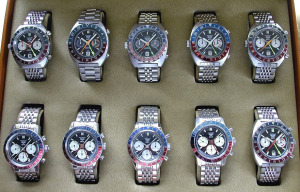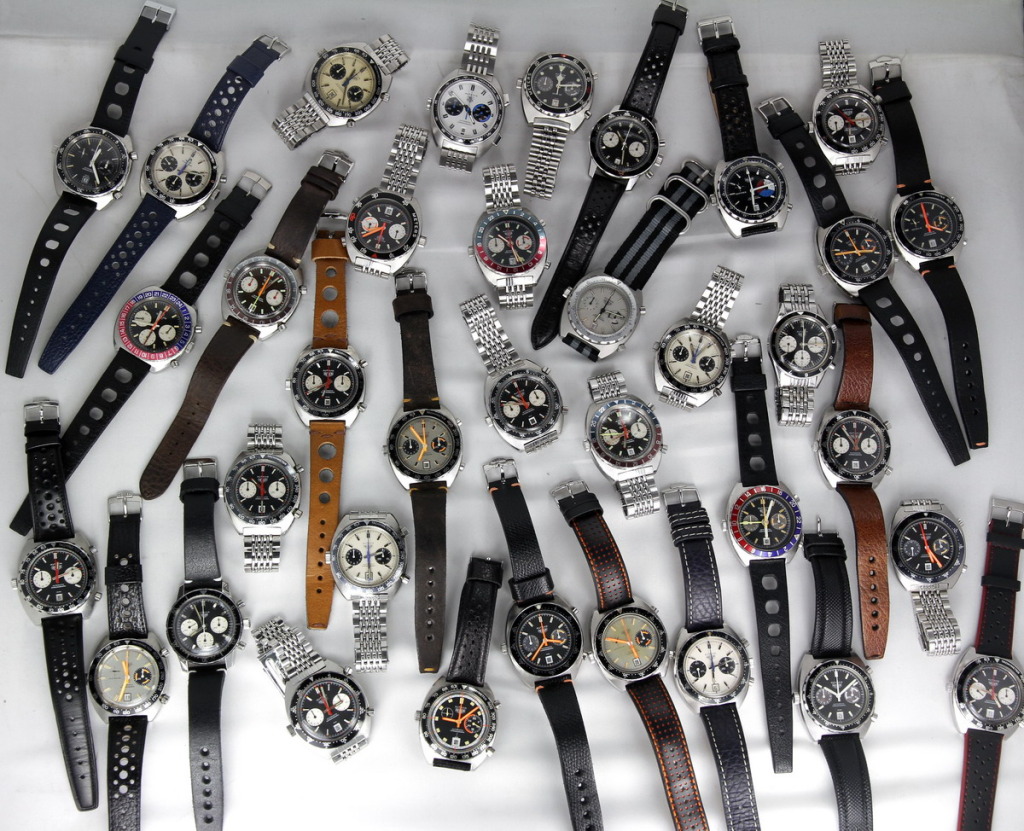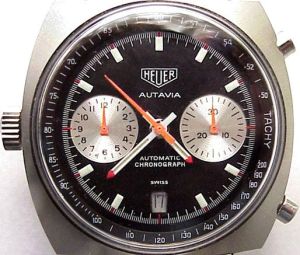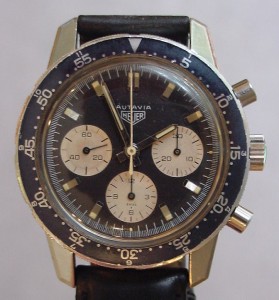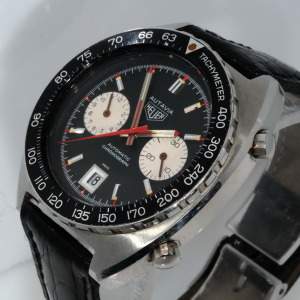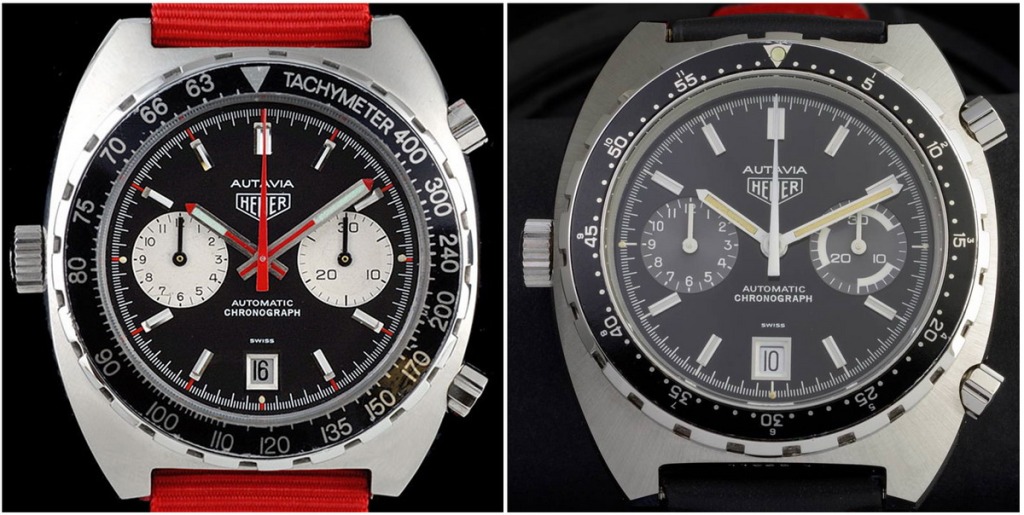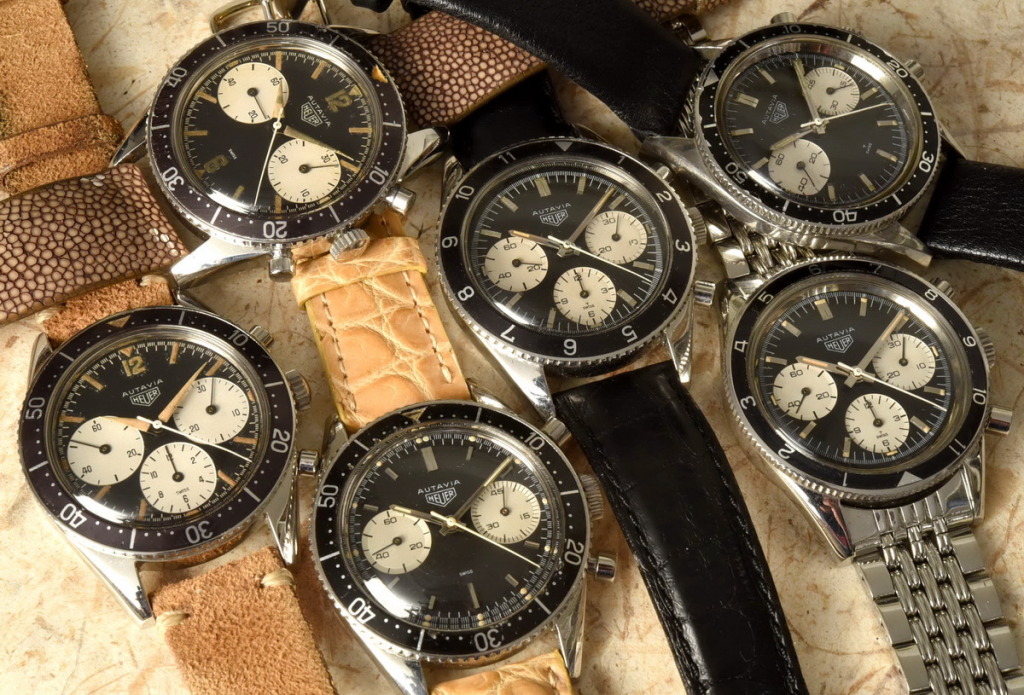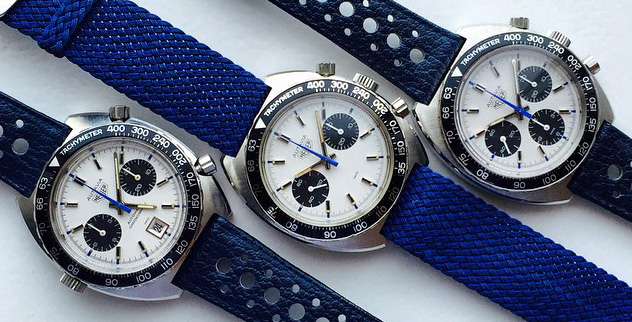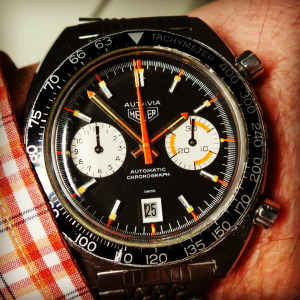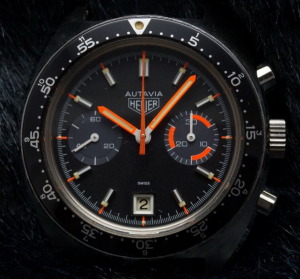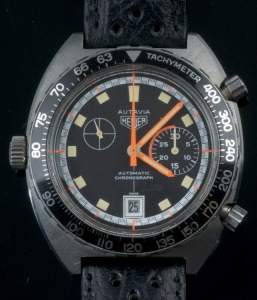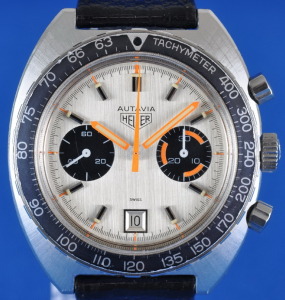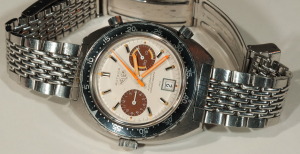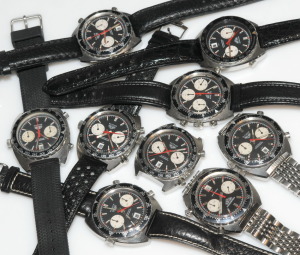Looking at the world of vintage Heuer chronographs, most of the action centers around three models — the Autavia, the Carrera and the Monaco. Over the years from 1962 into the mid-1980s, there were over 200 executions and variations of these three models, ranging from manual-winding two-register chronographs, to more complicated GMT models, to quartz powered models with dual digital displays. While Heuer offered many other models over these years (for example, the Camaro, Montreal, Silverstone and Monza), these other models together account for only a fraction of the production of Heuer’s “Big Three.”

Heuer’s “Big Three” — Among the most common executions of these models are the “Viceroy” Autavia
(1972), the Reference 2447S Carrera (circa 1963), and the “Steve McQueen” Monaco (circa 1970)
In this posting, we provide an overview of the first of Heuer’s “Big Three” models, the Autavia. Our overview of the Autavia provides information for today’s collectors. We focus on the versions of the Autavia that are most accessible to today’s collectors, rather than the very rare executions or prototypes that today’s collector cannot expect to find (or afford). (For example, we will not cover the Chronomatic Autavias here; for those who may be interested in the Chronomatic Autavias, I have written a separate posting covering the “Chronomatics”.)
The Autavia, Carrera and Monaco all share the connections to motorsports and racing that make vintage Heuers a favorite for collectors, while each of the models offers collectors different looks and features. The Carrera is Heuer’s design icon, purpose-built for racers who wanted the utmost in legibility under difficult racing conditions. Worn by Steve McQueen, the Monaco offered an outrageous circle-in-the-square design and bold colors that positioned Heuer for new series of racing watches in the 1970s.
Autavia — The Racer’s Watch
While the Carrera has the beautiful racing name, and the Monaco evokes both the Formula One and the 24 Hours of Le Mans, history shows us that the Autavia was the chronograph most often worn by the racers. Formula One champions Mario Andretti and Jochen Rindt wore manual-wind Autavias in the late 1960s.
Jo Siffert, Gilles Villeneuve, Clay Regazzoni and Derek Bell wore automatic Autavias in the 1970s.
Looking beyond these professional racers, through a promotion with the Viceroy cigarette brand in 1972 (which we discuss below), the Autavia become popular with thousands of grass roots racers, who were accustomed to using Heuer stopwatches for race timing.
Origins of the Autavia
Over the decades from its founding in 1860 through the 1950s, the main lines of Heuer chronographs did not have model names. Instead, models were described only by their reference numbers . For example, the Reference 346 was a three-register chronograph powered by the Valjoux 71 in a stainless steel case with rounded lugs, while the Reference 2447 used the Valjoux 72 in a stainless steel case with more angular lugs. In 1962, this changed, as Heuer began to give its chronographs model names, which would be printed at the top-dead-center of the dial.
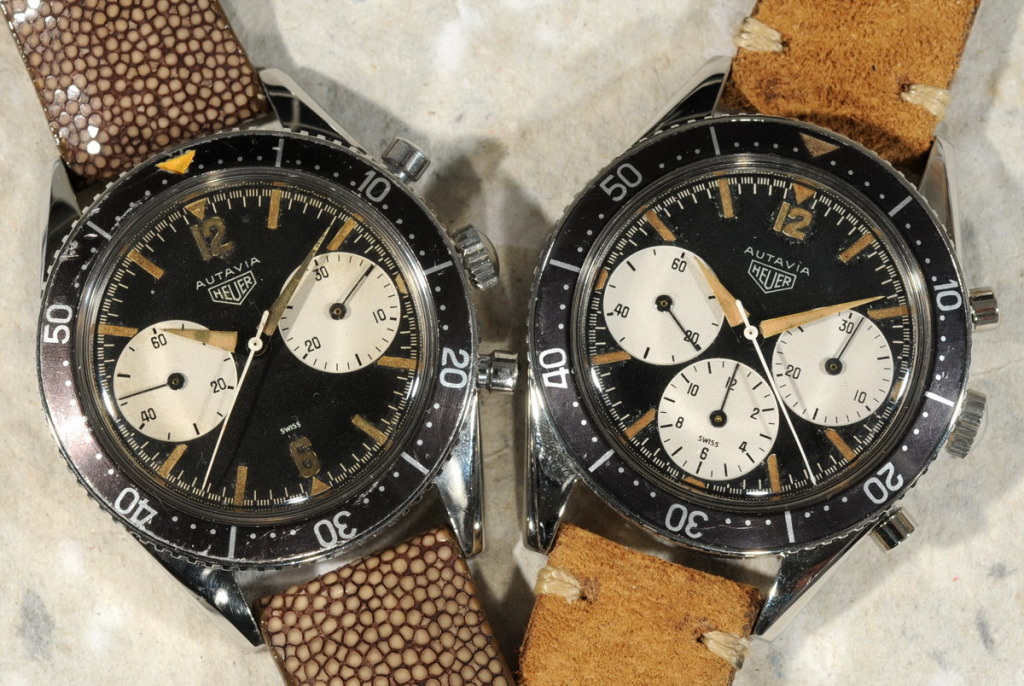
The first versions of the Autavia had lume-covered dauphine hands and larger registers than the later models.
In selecting “Autavia” as its first model name, Heuer drew on the name that it had used for a series of dashboard timers for over two decades. In 1933, Heuer had combined the words AUTomobile and AVIAtion to create the “Autavia”, a stopwatch with 12-hour capacity. The reference to motorsports and aviation was more than a marketing device, as the Autavia was designed to offer the racer or the pilot a timer that was extremely rugged and highly legible.
The dashboard-mounted Autavias became the standard for racers and rally navigators from the mid-1930s through the late 1950s, when Heuer replaced the Autavia with the new Monte Carlo model.
The Cases.
The Autavias used six primary styles of cases over the years, all made of stainless steel, as follows:
- 1960s Screw-Back Cases. Heuer used two types of screw-back cases for the first Autavias, the first execution from 1962 to 1965, and the second execution from 1967 to 1969. Both these cases measure approximately 39 millimeters across the dial and 13 millimeters thick (from the back of the case-back to the top of the crystal), with the main cosmetic difference being the wider bezel on the earlier model and the narrower bezel on the later model.
- Compressor Case. The Autavia moved to a snap-back “compressor” case in 1969, with this case being used into the early 1970s. The compressor back and seal offered improved water-resistance. This case was larger than the screw-back cases, at 40.4 millimeters across the dial and 13.5 millimeters thick, with distinctive angular lugs.
- 1970s-Style Cases. In order to accommodate its larger automatic movement, the Autavia moved to an entirely new case in 1969. The first of these cases was the Reference 1163 (which had a plastic crystal), and then the Reference 11630 and 11063 (which had mineral crystals). All these 70s Autavias measured approximately 42.5 millimeters across the dial, with a thickness of 15 millimeters.
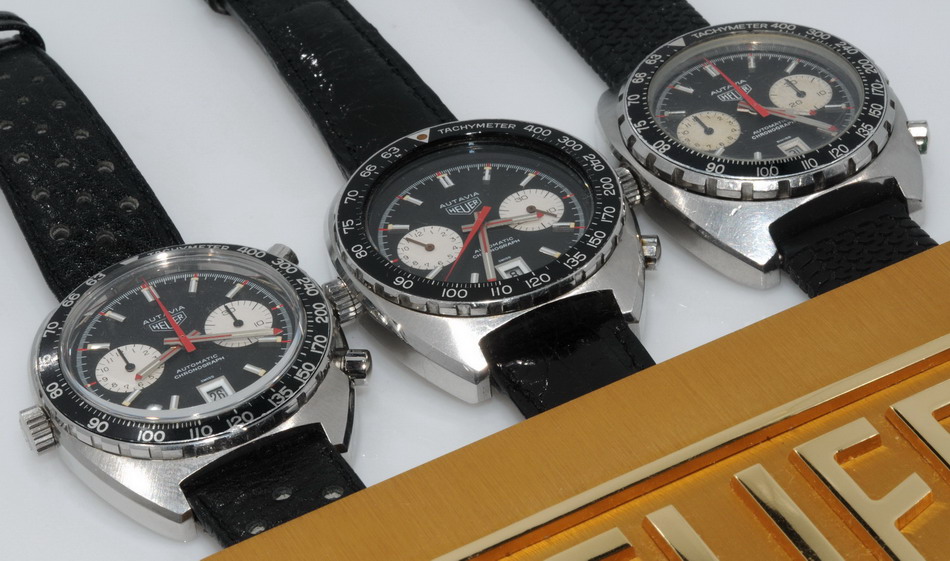
Automatic Autavias from the 1970s and 1980s — Reference 1163 (left), 11630 (center) and 11063 (right)
In addition to the Reference 1163 case for the automatic Autavia, there were similar styled cases for manual-wind versions that were produced in the 1970s.
The Autavia’s Defining Feature — The Rotating Bezel.
Throughout its model life, the defining feature of the Autavia chronograph was a rotating bezel. In addition to being able to time events with the Autavia’s chronograph, these rotating bezels provided the user with a supplemental timing device. Different bezels could display elapsed time (in minutes or hours), countdowns to a fixed time (useful for diving) or a second time zone (on the GMT models). For the racer, the Tachymeter scale translates the time over a measured mile (or kilometer) into the pace for that distance.
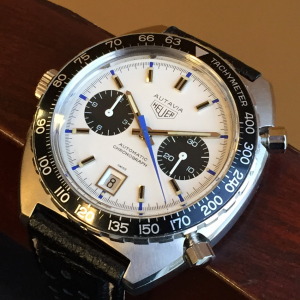
The tachymeter bezel translates the time over a measured distance into the speed over that distance.
In the 1970s, Heuer introduced two special bezels for divers, one the traditional minute countdown and another to time decompression.

This rare version of the Autavia has a “decompresion” bezel, to allow a diver to safely return to the surface.
Other brands had used fixed bezels to give chronographs a sporty look; the Autavia’s rotating bezel was a tool that was actually used for timing events. [Here is a separate OnTheDash posting discussing the use of a rotating tachymeter bezel.]
The Dials.
For the first seven years of their production, Autavias dials followed the approach of the Ford Model T automobiles, coming in any color the customer wanted, as long as that color was black. Each of these black dials had contrasting white registers.
White dials arrived with the automatic “Siffert” models in 1969, and by the end of its run in the mid-1980s, Autavias had also used silver, cream, green, gold and gray dials.
The Movements.
The first manual-wind Autavias were powered by Valjoux movements — the V72 for three registers, the V92 for two registers and the V724 for the GMT models. Heuer switched to the Valjoux 7730 (two registers) and 7732 (two registers, with date) movements in the late 1960s. Starting in 1969, automatic Autavias were powered by the full range of Caliber 11 movements and its derivatives, Cal 11i, Cal 12, Cal 14 (for GMT) and Cal 15 (30 minute capacity). More Valjoux movements followed for the manual-wind movements of the 1970s, including the 7733 (two register), 7734 (two registers, with date), 7736 (three register), 7740 (two registers, including chronograph hours, with date) and 7741 (GMT with date). All told, the Autavias were powered by 14 different movements.
The GMTs
The Autavia’s rotating bezel offered the perfect opportunity for Heuer to offer its first GMT chronograph, and in 1967 Heuer added a fourth hand to the center pinion of the Autavia for the GMT function. This fourth GMT hand may not be set or adjusted independently of the main hour hand, but shows the same time as the main hour hand, expressed on a 24-hour basis. The user rotates the red and blue bezel to show the correct time in a second time zone, with the GMT hand pointing to the 24-hour time on the bezel.
Heuer offered Autavia GMT chronographs in six different cases. Manual-wind versions of the Autavia GMT used the second execution screw-back case (circa 1967), the compressor case (circa 1969), and a 1970s style case. The automatic Autavia GMTs were housed in all three of the cases used for the automatic Autavias — Reference 1163, Reference 11630 and Reference 11063.
The Executions.
Loading the Autavia’s six primary cases with this variety of dials, a range of bezels, a GMT feature, 14 movements, and both stainless steel and color-coated finishes, we arrive at over 80 different versions of the Autavia.
Collecting Autavias.
In today’s market for vintage chronographs, we see more Autavias than any other model of Heuer chronograph. At a given time, the collector should be able to find a few dozen nice Autavias offered for sale through dealer websites, on eBay or on buy / sell / trade forums. Compared with the quantity of chronographs produced by other brands (for example, Rolex, Omega and Breitling), this may seem like a small number, which only highlights the relatively small size of the vintage Heuer market.
One bit of good news for today’s collectors is that we have seen very few fake Autavias, at least in the past few years. Earlier (say, between 2000 and 2005), we saw a series of Autavias with fake dials, easily detected by the placement of the Heuer shield above the word “Autavia”. The watch shown below says “Autavia” on the dial, but no element — dial, case, hands or inner bezel — appears to be genuine.
The beginner should, however, be alert to the existence of “Frankens” — Autavias that use elements from other models. With so many Heuers using the same movements, the collector should be careful about the watchmaker who has assembled a watch with incorrect hands, pushers, etc.
The Elephant in the Room — Today’s Prices
In any discussion about collecting vintage Autavias, in the year 2015, there is a topic that cannot be ignored — the strong increase that we have seen in prices for the the vintage Autavias in recent years. Over the past few years, the price of just about every vintage Autavia has increased substantially (say, up 30% over the past two or three years, at the bottom of the range), while the prices of the high-end Autavias have just about exploded (doubling or even tripling, over this period). Before recommending any Autavias for today’s collectors, we need to understand the recent surge in prices, so that the collector can make an informed decision about purchasing an Autavia in the current environment.
Three years ago, I wrote an article “Heuers Are on a Roll“, seeking to explain the strength of the vintage Heuer collecting community and the market for these watches. If I had to boil that article down into a few bullets, they would read as follows:
- Great Looking; Excellent Quality. The vintage Heuer chronographs are great looking watches and, because of their high-quality components and construction, they have survived well over the years. Stainless steel cases; Singer dials; and Valjoux movements were top-quality components in the 1960s, and they can still look brand new today. Watches of some other brands may not have survived as well.
- Motorsports Heritage. Collectors enjoy Heuer’s motorsports heritage and imagery, especially from the 1960s and 70s. The brand’s vibrant history is well-publicized in today’s magazines, websites, forums and books.
- A Safe Market. There is a lot of information readily available about the vintage Heuers and people think of it as a relatively safe market. Some vintage brands have an alarmingly high percentage of fakes and “Frankens”; with the Heuers, a diligent buyer should be able to make a purchase with a reasonable level of confidence. From a financial perspective, the market for vintage Heuers has not had any major downturns or corrections in recent years.
- The Community. There is a strong community that collects vintage Heuer chronographs and participating in this community adds to the enjoyment of collecting.
- Broad Price Range. There is a broad price range among the models, with an attractive selection of entry-level models.
- Support from TAG Heuer. TAG Heuer has supported the Heuer brand and its heritage, and used rich imagery and heroic figures from the 1960s and 70s. The re-issue of numerous Carreras and Monacos has increased interest in the Heuer brand and its vintage chronographs.
Three years later, in seeking to explain the increased prices for the vintage Autavias, I would repeat each of these factors, and also point to a few additional ones.
- The Financial Markets have Been Strong. The Dow Jones Industrial Average has increased by 43 percent over the last three years (from 12,640 on June 18, 2012 to 18,115 on June 18, 2015) . . . so if the DJIA has increased by 43 percent over the past three years, what’s wrong with a Viceroy Autavia going up 30 percent or a “Siffert” going up 50 percent?
- Strong Prices for Collectibles. Markets for collectibles have been very strong over the last three years, including many categories of “alternative investments” (such as automobiles, art and wine). Whether because of fiscal policy or the economic expansion, there is a lot of money in the world right now, and some of the people who have a lot of this money want to but fine watches, vintage and modern.
- Watches Have Done Well. We have seen strong gains across many brands of vintage watches (including the bell-weather brands, Rolex and Patek Philippe), as well as other brands that collectors might think of as comparable to Heuer (for example, Breitling and Omega).
- Rotation between Brands. As the prices of some high-end vintage watches have skyrocketed (for example, sport Rolex), some collectors have found the vintage Heuers to be relatively inexpensive. Over the last three years, I have gotten a lot of email messages to the following effect, “I have been collecting vintage Rolex watches for a long time and have recently gotten interested in the vintage Heuers.”
- Heuers are Relatively Scarce. The supply of top-quality vintage Heuer chronographs seems to have almost dried up over the last few years. Compared with some other leading brands, Heuer produced relatively few watches “back in the day”. Many of the most desirable Heuers seem to have been purchased by collectors with “strong hands”, and these watches do not come onto the market, because of minor economic set-backs.
Beyond the factors that I have outlined above, I can’t explain the sharp increase in prices for vintage Heuers that we have seen over the past two or three years. I also can’t explain what we have seen over the past 15 years.
Accordingly, I won’t hazard a prediction about what we will see going forward. But I will say that I feel safe buying high-quality Heuers, at today’s prices.
OK . . . enough about the elephant in the room. Now, let’s have a look at some watches!!
Some Recommended Autavias.
So which of the Autavias do we recommend for collectors who may be new to vintage Heuers? Selecting the right Autavia will depend on the collector’s aesthetic preferences and requirements for specific “tools”, as well as his budget. The following models provide some good choices for those entering the world of vintage Autavias. We will avoid the super rare models (for example, the very first models from 1962 and the first automatic models from 1969), with the models that we cover offering reasonable availability for the diligent collector.
The Place to Start
In 1972, Heuer produced approximately 5,000 automatic Autavias for a promotion in which the Viceroy cigarette company offered Autavias for $88 (when the same model was selling for $200 through retailers). (Both these models are shown below.) At the time, Viceroy was sponsoring the Vels-Parnelli Jones racing team, and the “Viceroy” Autavias were popular among racing enthusiasts. The Viceroy Autavia (Reference 1163) is an automatic chronograph, with a black dial and rotating tachymeter bezel. The Viceroys remain the most plentiful of the “Big Three” vintage Heuers; at any given time, you should find a handful offered on eBay or by dealers. You can spend between $2,500 and $3,000 for a good sample of the Viceroy Autavia. [Read more in this Hodinkee feature, “Ode to Smoke”, covering the Viceroy Autavia].
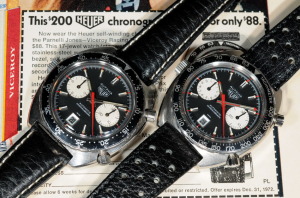
The Reference 1163 MH (on the left) was selling for $200 at the time that Heuer offered the “Viceroy” model (on the right) for $88. Components and construction are of identical quailty.
The Entry-Level Autavias
In the original version of this posting, from June 2013, we suggested that the best bargain / “beater” Autavia would be a snap-back (compressor) cased Autavia, from the late 1960s – Reference 2446C (three registers) or Reference 7763C (two registers). We suggested that if you are OK with some patina and battle scars, you might find a decent Autavia 2446C in the $1,000 to $1,500 range; double that for a mint model. Over the last two years, however, prices for the 2446C Autavias have jumped to the $3,500 to $4,500 range, so we will need to look elsewhere for entry-level choices.
With the compressor-cased Autavias moving beyond “entry level”, what are the recommendations for today’s bargain basement Autavias? Noting that the value of Autavias may be inversely proportional to their size and weight, the least expensive way to begin an Autavia collection may be with largest executions — the 11630 and 11063 automatic models.
The Reference 11630 Autavias, in Viceroy colors, are relatively plentiful in today’s market, meaning that at any given time, you might be able to find a couple of samples offered on eBay or through dealers. The 11630s tend to sell for less than the Reference 1163 Viceroys, and we are currently seeing them offered in the $2,000 to $2,500 range.
The second recommendation for an entry level Autavia is the Reference 11063 model, the very last of the automatic Autavias. We see these priced at around the level of 11063, and we leave it to the buyer to make the choice. The 11063 has distinctive “teeth” on the bezel and is wider between the lugs (21mm versus 20mm). It’s a rock-solid chronograph at a reasonable price, compared with the older siblings.
What’s Hot, Right Now
Over the past year, the category of Autavias that has experienced the strongest increase in popularity (and prices) has been the screw-back, manual wind Autavias from the 1960s. The very first models, with the all-lume hands and larger registers [shown below left] are currently selling in the $15,000 to $25,000 range, with very few of these models offered publicly. The later Autavias in screw-back cases are currently changing hands in the range between $5,000 and $10,000, with a regular flow of these available on eBay and through dealers.
The Sifferts
Jo Siffert was a Swiss Formula One hero and may be the ultimate racer in the Heuer constellation. To help cover his living expenses, Siffert sold Heuer chronographs to other Formula One racers, and even managed to sell a Porsche 911 to Jack Heuer. Siffert’s Autavia of choice was an automatic model (Reference 1163T), with a bright white dial and blue and black accents (three samples shown below). Check this profile of Jo Siffert, in AutoWeek. For a “Siffert” Autavia in tip-top condition, expect to spend $8,000 to $15,000, with the earlier models commanding the higher prices.
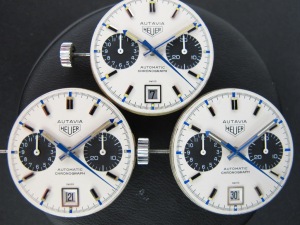
Autavia Reference 1163T (“Siffert”) chronograph. This is the final execution, with brushed steel hands and 1-through-12 on the chronograph hour recorder. Photo courtesy of Abel Court.
If you are determined to have the Siffert color scheme on a lower budget, then you might be able to find a manual-wind version.
Something Different — Military Autavias
The rugged construction, excellent legibility and rotating bezel made the Autavia an ideal chronograph for pilots, divers and other military personnel. The Argentina Air Force issued Reference 2446C Autavias in the late 1960s, with other models being use din the 1970s. The Israel Defense Forces issued Autavias to some elite units in the 1970s, and you can find different models for divers, pilots and infantry officers. Finally, the Kenyan Air Force issued a variety of Autavias, both automatic and manual-wind, in the 1970s.
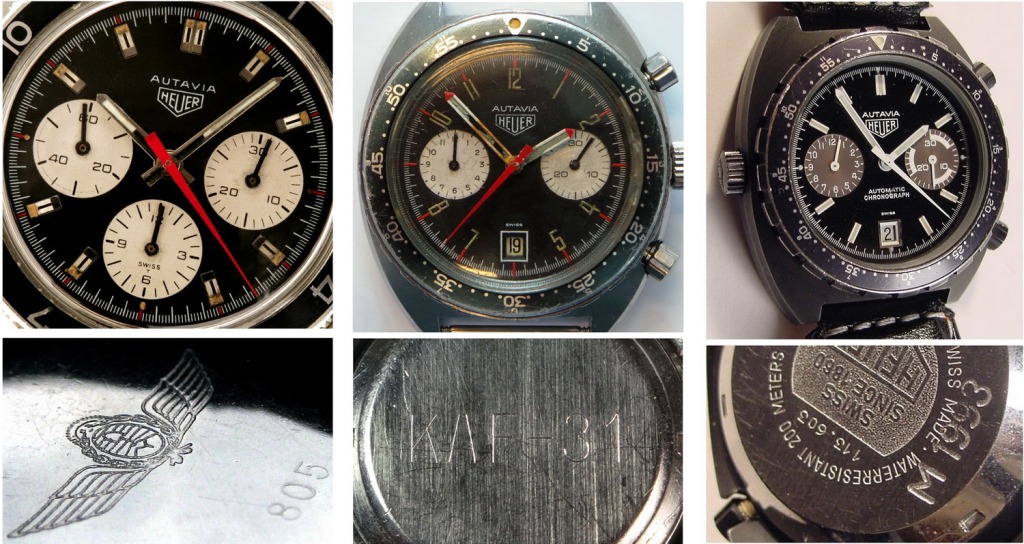
Three military Autavias, marked to show issuance by armed forces of Argentina (Reference 2446C), Kenya (Reference 741.603) and Israel (Reference 113.603).
The military Autavias are rare and they do command a premium above the comparable “civilian” models.
Orange is the New Black
So far, most of the Autavias that we have discussed have featured two colors — black and white. Yes, we have some beautiful aged lume, and we have some blue accents on the “Sifferts” and red accents on the “Viceroys”, but what can we recommend for the enthusiast who want some color . . . I mean some real color? Let’s say orange, for example?
For the enthusiast seeking some orange accents on his Autavia, but wanting to keep it somewhat “mild”, we would go with the Autavia known as the “Orange Boy”. This Reference 1163 Autavia is identical to the Viceroy model, except that the red accents of the Viceroy are replaced with orange accents. These are rare models, commanding prices above the $10,000 mark.
If you want stronger orange tones than offered by the “Orange Boy”, then you may like the Reference 11630 MH, featuring the painted orange hands and racing stripes (on the minute register). Budget $4,000 for this 11630 MH Autavia.
For the collector who wants the full-on, psychedelic-70s Autavia experience, we recommend the Caliber 15 “Exotic” Autavia. The Caliber 15 movement deletes the hour recorder and moves the running seconds register up to 10 o’clock, so that the “Exotic” Autavia has an asymmetrical dial. The oversized lume markers and hash-mark track complete a watch that captures the style of the 1970s. The “Exotics” have also been strong gainers in recent years, now selling above the $12,000 level.
Win the Silver Medal
So if you are bored of the black dials, and bored of the white dials, how about an Autavia with a very special dial — a dial with a brushed silver finish? This dial was first used in the Reference 11630 Autavia (circa 1972), but was used in several additional models, including the manual-wind Autavia shown below. Most photos don’t convey the brilliant finish on these dials, but when you see it in-the-metal, you will see how special they are. Budget around $4,000 for a nice 11630 with this brushed silver dial.
Additional Resources.
There are at least 80 executions of the Heuer Autavia, and we have covered only a handful of them in this posting. We have covered the pilot’s GMT chronograph, but not the diver’s watch. We have stuck to stainless steel cases, rather then the PVD-coated ones. The “Orange Boy”, but what about the “milk chocolate” (shown below). We will hope to address more of the Autavias in subsequent postings.
Here are some additional resources for collectors seeking information about the vintage Heuer chronographs.
- For detailed information about the Early Autavias, see An In-Depth Look at the Early Autavias (1962 through 1969). If you are interested in the very first Autavias, visit our Registry of Early Autavias.
- To see the full catalog of Autavias offered by Heuer, from 1962 through the mid-1980s, visit the Autavia section of OnTheDash
- At the bottom of the Autavia home page, there is our Autavia Reference Table, providing detailed information covering over 80 executions of the Autavia.
- You may also enjoy the book, “Heuer Autavia Chronographs 1962-85“, written by Rich Crosthwaite, with beautiful photographs from Paul Gavin.
- Rich Crosthwaite, who operates the Heuer Central website, has published Price Guides, one covering the 1960s Autavias and one covering the 1970s and 80s Autavias.
- Paul Gavin’s “HeuerWorld” website has the best photographs of vintage Heuer chronographs. He has separate sections for the manual-wind Autavias and the automatic Autavias.
- Here’s a posting about the “Siffert” Autavia that was the subject of an episode of Pawn Stars, “What’s It Worth? Heuer Autavia Sold on Pawn Stars“.
- Stewart Morley’s Heuerville blog has lots of postings covering the Autavias; this link will take you to these postings.
Good luck as you pursue these old Autavias, the racer’s chronograph from the Golden Age of motorsports!!
Jeff Stein
June 21, 2015
[Updated, in part, March 31, 2016]
